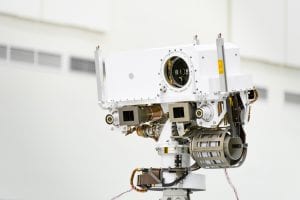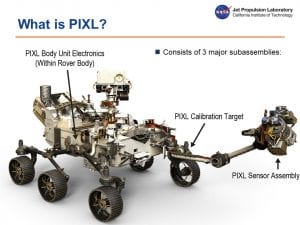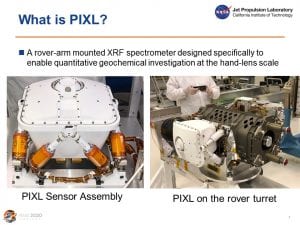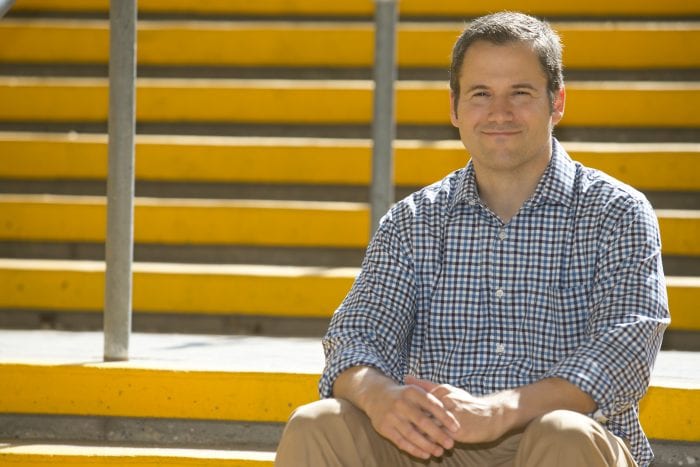By Daniel Dunaief
February 18th marked an end and a beginning.
On that day, the Mars Perseverance rover descended through the atmosphere with considerable fanfare back on Earth. Using some of the 23 cameras on Perseverance, engineers took pictures and videos of the landing.
The National Aeronautics and Space Administration not only shared the video of the rover descending into the Jezero crater which held water and, perhaps, life three billion years ago, but also offered a view of the elated engineers who had spent years planning this mission.
In a calm, but excited voice, a female narrator counted down the height and speed of the rover, which weighs about a ton on Earth and closer to 800 pounds in the lower gravity of Mars. The NASA video showed staff jumping out of their seats, cheering for the achievement.
Launched from Cape Canaveral, the rover took 233 days to reach Mars, which is about the gestation period for a chimpanzee.
Some of the engineers “who got us there have reached the end of their marathon,” said Joel Hurowitz, Associate Professor in the Department of Geosciences at Stony Brook University and Deputy Principal Investigator for one of the seven scientific instruments aboard the Perseverance.
With ongoing support from other engineers who helped design and build the rover, the scientists “get the keys to the vehicle and we get to start using these things.”
Indeed, Hurowitz and Scott McLennan, Distinguished Professor in the Department of Geosciences at Stony Brook University are part of teams of scientists who will gather information to answer basic questions about Mars, from whether life existed, to searching for evidence of ancient habitable environments, to seeking evidence about the changing environment.
Both Stony Brook scientists were riveted by the recordings of the landing.

Hurowitz marveled at the cloud of dust that formed as the rover approached the surface.“You could see these chunks of rock flying back up at the sky crane cameras,” he said. “I was amazed at the amount of debris that was kicked up in the landing process.”
Hurowitz had seen pieces of rock on top of the Curiosity rover after it landed, but he felt he understood more about the process from the new video. “To see it happening, I realized how violent that final stage of the landing is,” he said.
McLennan said this has been his sixth Mars mission and he “never tires of it. It’s always exciting, especially when there is a landing involved.”
Like Hurowitz, who earned his PhD in McLennan’s lab at Stony Brook, McLennan was impressed by the dust cloud. “I understood that a lot of dust and surface debris was displaced, but it was quite remarkable to see the rover disappear into the dust for a short while,” he wrote in an email.
While previous missions and orbiting satellites have provided plenty of information about Mars, the Perseverance has the potential to beam pictures and detailed analysis of the elements inside rocks.
Hurowitz, who helped build the Planetary Instrument for X-ray Lithochemistry, or PIXL, said the team, led by Abigail Allwood at the Jet Propulsion Laboratory, has conducted its first successful instrument check, which involves turning everything on and making sure it works. Around April, the PIXL team will start collecting its first scientific data.
In addition to searching for evidence of previous life on Mars, Hurowitz will test a model for climate variation.

From measurements of the chemistry and mineralogy of sedimentary rock, the scientists can deduce whether the rocks formed in an environment that was oxygen-rich or oxygen-poor. Additionally, they can make inferences about temperature conditions based on their chemical compositions.
Looking at variations in each layer, they can see whether Mars cycled back and forth between cold and warm climates.
Warmer periods could have lasted for hundreds, thousands or even tens of thousands of years, depending on how much greenhouse gas was injected at any time, Hurowitz explained. “Whether this is long enough to enable biological development is probably one of the great questions in the field of pre-biotic chemistry,” he said.
The Martian atmosphere could have had dramatic swings between warm and oxygen-poor conditions and cold and oxygen-rich conditions. “This has not really been predicted before and provides a hypothesis we can test with the rover payload for how climate might have varied on Mars,” he added.
Tempering the expectation of confirming the existence of life, Hurowitz said he would be “shocked if we woke one morning and a picture in the rover image downlink [included] a fossil,” he said. “It’s going to take time for us to build up our understanding of the geology of the site well enough.” The process could take months or even years.
 Using information from orbiters, scientists have seen minerals in the Jezero crater that are only found when water and rock interact.
Using information from orbiters, scientists have seen minerals in the Jezero crater that are only found when water and rock interact.
With the 11-minute time lag between when a signal from Earth reaches Perseverance, Hurowitz said scientific teams send daily codes up to the rover and its instrument. Hurowitz will be involved in uploading the signals for PIXL.
A Martian day is 40 minutes longer than the Earth day, which is why the Matt Damon movie “The Martian” used the word “sol,” which represents the time between sunrises on Mars.
McLennan, who works on three teams, said PIXL and the SuperCam provide complementary skill sets. With its laser, the SuperCam can measure the chemical composition of rocks at under seven meters away. Up close, PIXL can measure sub millimeter spot sizes for chemistry.
SuperCam will then find areas of interest, enabling PIXL to focus on a postage-stamp sized area.
 As a member of the Returned Sample Science Working Group, McLennan, who is a specialist in studying the chemical composition of sedimentary rocks, helps choose which rocks to collect and set aside to bring back to Earth. The rocks could return on a mission some time in the 2030s.
As a member of the Returned Sample Science Working Group, McLennan, who is a specialist in studying the chemical composition of sedimentary rocks, helps choose which rocks to collect and set aside to bring back to Earth. The rocks could return on a mission some time in the 2030s.
The scientists will collect up to 43 samples, including some that are completely empty. The empty tubes will monitor the history of contamination that the other rock samples experienced.
For McLennan, the involvement of his former student is especially rewarding. Hurowitz “didn’t just help build the instrument, he’s one of the leaders,” McLennan said. “That’s really fabulous.”
For Hurowitz, any data that supports or refutes the idea about the potential presence of life on Mars is encouraging.
He is “cautiously optimistic” about finding evidence of past life on Mars. “We’ve done everything we can as a scientific community to maximize the chance that we’ve landed some place that might preserve signs of life.”





